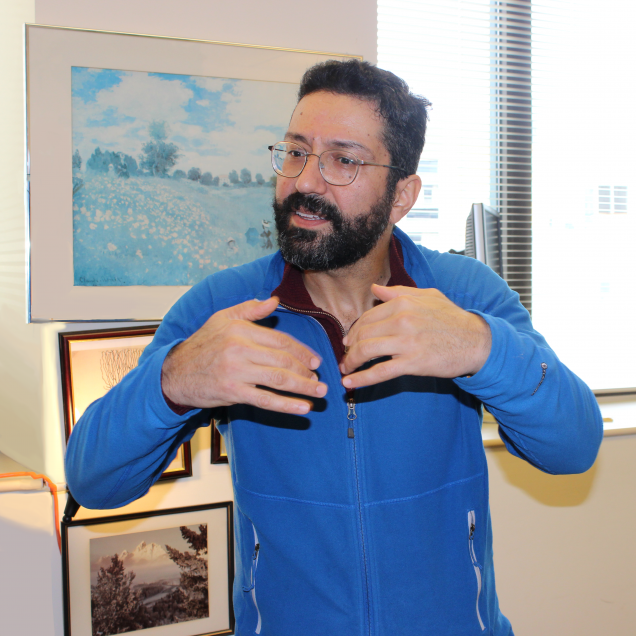FACULTY FEATURE: Arash Yazdanbakhsh

Stepping onto Commonwealth Avenue the Wednesday morning after the Red Sox won the World Series was a thrill. Barricades were already set up along the streets, fans were lining up in their jerseys, and kids were jumping at the bit to see their heroes parade before their eyes through the city streets. And yet, it was a conversation at 677 Beacon St. with Dr. Arash Yazdanbakhsh that radiated much more passion than any trophy possibly could.
6,191 miles; that’s how far Dr. Yazdanbakhsh travelled from Iran to move to the United States. Already an MD in Iran before leaving, Dr. Yazdanbakhsh described practicing medicine in Iran as much different than in the United States. In Iran, an MD was expected to maintain an additional one or two other jobs in order to make a living. By submitting peer-reviewed papers to American professors via email, Dr. Yazdanbakhsh was noticed in the American research scene. Through his outgoing attitude, Dr. Yazdanbakhsh secured a spot at Boston University, where he ultimately obtained a Ph.D. in computational neuroscience.
When asked about role models, Dr. Yazdanbakhsh quickly mentions Albert Einstein. After reading one of Einstein’s books, Dr. Yazdanbakhsh was astounded by Einstein’s love of physics and mathematics. Dr. Yazdanbakhsh applied his love for physiology and found his passion in neuroscience, a field that has incredible room for innovation in combination with a subject as meticulous as mathematics.
When he first started in research, Dr. Yazdanbakhsh was involved with experiments on perception and visual experience that used eye tracking to record data from virtual reality. Tying this to reaction times, Dr. Yazdanbakhsh inferred what certain saccades meant when they occurred. This was done through the gathering of multitudes of data, then the deep analysis of the data through computer models and programs. In later research, Dr. Yazdanbakhsh became involved in researching other forms of neural modeling, the psychophysics behind Parkinson’s disease, and electrophysiology.
At Boston University, Dr. Yazdanbakhsh teaches NE 212, CN 510, and CN 530. NE 212 introduces students to the fundamentals of statistical research via MATLAB. This course focuses on explaining numerical integration programs through two settings: probability distributions and simulations of neural dynamics. CN 510/530 – Neural and Computational Models of Vision – delves into the constraints of mammalian visual processes through neural and computational models found using computer simulations.
In all his courses, Dr. Yazdanbakhsh praises the work of his students.
“The most gratifying thing is when a student of mine is thinking hard to solve a problem, and then steps outside the normal techniques and begin to think of novel ideas, more like a colleague of mine rather than a student,” Dr. Yazdanbakhsh said.
Dr. Yazdanbakhsh pairs hard thinking with creativity, and experimental design with thoroughness, all of which he describe as essential tools in a scientist’s toolkit.
For incoming neuroscience students, Dr. Yazdanbakhsh recommends building a broad view of the basis of neuroscience rather than specializing in a certain topic from the get-go.
“While there can’t be exact advice, observe as much as possible your freshman year,” Dr. Yazdanbaksh said. “Network. Talk to other students that are participating in research and find what you are interested in. This will allow you to find your niche.”
Dr. Yazdanbakhsh comments on the importance of being a part of such a distinguished neuroscience department at Boston University.
“There is a wide range of colleagues that are close together and allows for a good amount of cross-pollination. This allows for better work,” Dr. Yazdanbakhsh said. He also states that the faculty of BU is constantly giving effort, not only for their own research, but for their colleagues’ as well. “BU is the perfect place where you can walk down the street and the environment just recharges you.”
When he’s not in the classroom or in the lab, Dr. Yazdanbakhsh loves to be physically active. With a playlist ranging from Baroque to soft rock, Dr. Yazdanbakhsh enjoys tackling the gym for a workout. “The music adds a sense of rhythmicity to my workout.” When possible, Dr. Yazdanbakhsh tries to get outside and hike, as he places a lot of emphasis in connecting with natural objects, including sunlight and the outdoors.
Dr. Yazdanbakhsh’s tie to nature is evident when you walk in his office for the first time and recognize the flowering green plant hanging in the middle of the ceiling, sprawling in every direction. Dr. Yazdanbakhsh compares the vines of his plant to the dendritic spines of the brain.
“At the peak of its growth, this plant may have a few hundred leaves, so just imagine the brain is 100 times denser than this plant,” Dr. Yazdanbakhsh said. Dr. Yazdanbakhsh’s comparison highlights the detailed interconnections necessary for brain function. Like the plant and the brain, scientists around the world must come together and work in unison to answer the “serious questions that have yet been left unanswered.”
Who knows? Once that happens, there may be another parade rolling down Comm Ave, just this time, not for baseball.
Written by Trey Moore
Edited by Brian Privett, Emme Enojado